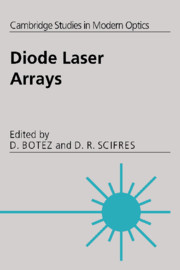Book contents
- Frontmatter
- Contents
- List of contributors
- Preface
- 1 Monolithic phase-locked semiconductor laser arrays
- 2 High-power coherent, semiconductor laser, master oscillator power amplifiers and amplifier arrays
- 3 Microoptical components applied to incoherent and coherent laser arrays
- 4 Modeling of diode laser arrays
- 5 Dynamics of coherent semiconductor laser arrays
- 6 High-average-power semiconductor laser arrays and laser array packaging with an emphasis on pumping solid state lasers
- 7 High-power diode laser arrays and their reliability
- 8 Strained layer quantum well heterostructure laser arrays
- 9 Vertical cavity surface-emitting laser arrays
- 10 Individually addressed arrays of diode lasers
- Index
4 - Modeling of diode laser arrays
Published online by Cambridge University Press: 10 November 2009
- Frontmatter
- Contents
- List of contributors
- Preface
- 1 Monolithic phase-locked semiconductor laser arrays
- 2 High-power coherent, semiconductor laser, master oscillator power amplifiers and amplifier arrays
- 3 Microoptical components applied to incoherent and coherent laser arrays
- 4 Modeling of diode laser arrays
- 5 Dynamics of coherent semiconductor laser arrays
- 6 High-average-power semiconductor laser arrays and laser array packaging with an emphasis on pumping solid state lasers
- 7 High-power diode laser arrays and their reliability
- 8 Strained layer quantum well heterostructure laser arrays
- 9 Vertical cavity surface-emitting laser arrays
- 10 Individually addressed arrays of diode lasers
- Index
Summary
Introduction
Diode laser arrays were conceived and fabricated in the late 1970s as an attempt to overcome the inherent power limitations of single-aperture diode lasers. Increasing the output power by simply increasing the lateral aperture size from the usual ≈ 5 μm to values of 50–100 μm had already been tried with disappointing results. These so-called ‘broad-area’ devices exhibited such poor modal characteristics that the power focusable into a diffraction-limited spot barely increased at all. Arrays were thus seen as a means of increasing output power by phase-locking several diode lasers together so that they operated as a single (hopefully) diffraction-limited source. The last decade has seen a tremendous research effort directed towards the design and fabrication of high-power arrays exhibiting good mode control, with (as usual) mixed results. Today's multi-watt arrays certainly provide more focusable laser power than could be obtained by simply stacking together individual diode lasers. On the other hand, achieving the desired mode control and coherence from arrays has proved considerably more difficult than was originally envisioned. As a result, virtually all the high-power arrays commercially available at present emit their radiation into two broad far-field lobes instead of the desired single diffraction-limited lobe.
This situation has arisen because the first simple types of diode arrays that were easily understandable and relatively easy to fabricate have been shown to exhibit poor mode discrimination, so that even devices that lased in the desired in-phase mode near threshold became multi-mode at higher currents.
- Type
- Chapter
- Information
- Diode Laser Arrays , pp. 180 - 225Publisher: Cambridge University PressPrint publication year: 1994
- 6
- Cited by



